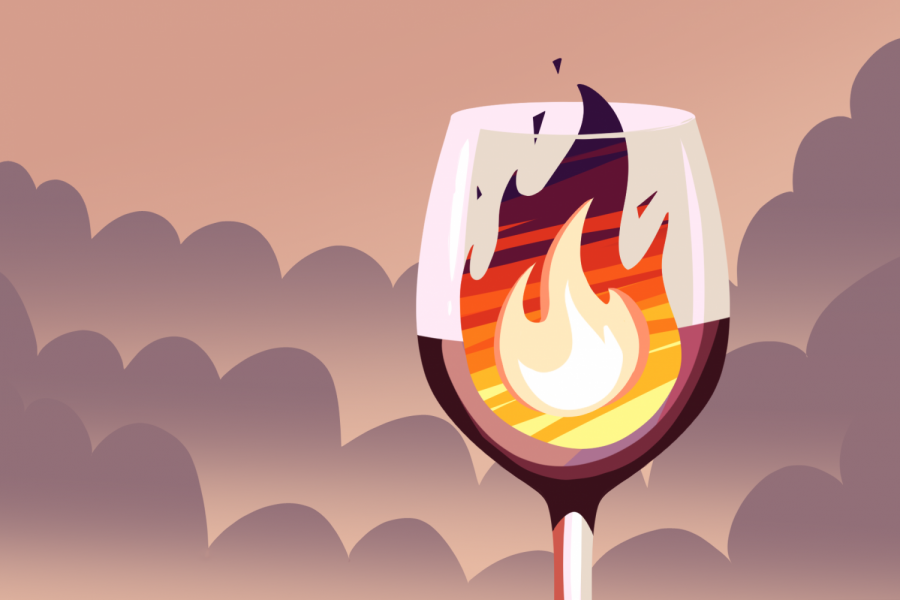Vineyards work with OSU researchers to disentangle impacts of wildfire smoke
Extension of OSU, Oregon Wine Research Institute, receives $7.65 million to uncover effects of smoke on wine
Illustration showing a fire encased in a wine glass; clouds of smoke can be seen in the background. Researchers at the Oregon Wine Research Institute are currently testing how wildfire smoke can affect the taste of wine.
November 29, 2021
As wildfires rampaged through Oregon in 2020, the air quality index soared into hazardous territory and smoke flooded the Oregon Coast and Willamette Valley where numerous vineyards reside.
According to a survey conducted by the California Wine Institute, over 1 billion gallons of wine were consumed by U.S. citizens in 2020. With an increasingly high demand for wine, vineyards throughout Oregon are worried the wildfire smoke negatively affects the flavors of their wines.
Wine having an off-taste discourages consumers from buying it. Even without tasting it, consumers are likely to avoid buying wine if there is the perception that it is poor quality, explained Vincent Vidrine, a winemaker at Benton Lane Winery located in Monroe, Ore.
“We don’t have a great understanding of what the market is going to do with wines that have any kind of impact from wildfire smoke,” Vidrine said. That, he posits, is the biggest threat to the industry as wildfires are projected to become more frequent and of greater magnitude.
Elizabeth Clark, a winemaker at Airlie Winery located in Monmouth, Ore., said that while Airlie was removed from the effects of smoke during the 2020 wildfire season due to its geographic location, it still felt the repercussions.
“Even when something impacts most people, even if I am not specifically impacted, it impacts the industry as a whole,” Clark said. “The consumer already knows there’s a problem with the 2020 vintage, so there’s already a strike again
st it coming out of the Willamette Valley.”
Last month, researchers at the Oregon Wine Research Institute, an extension of Oregon State University, received a $7.65 million grant to continue research on the impacts of smoke exposure on wine grapes.
Dr. Patricia Skinkis, professor and viticulture extension specialist at OSU, serves as the liaison between industry professionals and OWRI. After the wildfire season in 2020, Skinkis formed the Smoke Exposure Team in response to requests from the industry.
The team is led by Dr. Elizabeth Tomasino, an associate professor and sensory analyst at OSU. Other members of the team include Skinkis, Dr. James Osborne, Dr. Michael Qian and Dr. Alec Levin. All members specialize in viticulture, the study of grape cultivation, and enology, the study of wines.
When wine grapes are exposed to smoke at high concentrations, or for a prolonged period of time, they risk developing what researchers call smoke taint.
According to Tomasino, wines that have been tainted by smoke can develop an off-putting flavor.
“It’s sort of like licking an old ashtray,” Tomasino said.
Sensory tasting trials conducted by OSU Master of Science student Jenna Fryer have confirmed that consumers can taste the difference in wine that has been affected by smoke. According to Fryer, the majority of participants in the trials had an aversion to wines exposed to smoke.
Discovering the concentration of smoke compounds that is needed to alter the flavor of wine will enable industry professionals to decide whether they should put time and energy into harvesting their grapes. If they suspect that their grapevines have smoke taint, industries can save a lot of money by deciding not to harvest that crop.
Levin, an OSU associate professor and viticulturist, is working to find different threshold levels for smoke tolerance in wine grapes by conducting
dose-response smoke exposure experiments.
“Typically, when there’s a smoke event, it’s not going to be like you’re smoking meat in a smoker, it’s always pretty mild to moderate levels of smoke over longer periods of time rather than an intense shot,” Levin said. Putting grapes under a specific concentration of smoke over allotted periods of time will give the researchers a better idea of what conditions lead to smoke taint in wine.
Levin also said variability in smoke taint can be different depending on the grape variety.
Smoke taint occurs when molecules from the smoke leech into the fruit, primarily through their skin. When they attach themselves to the grape, they get bound as sugars and cannot be smelled or tasted. It isn’t until fermentation, when the bound molecules separate into free compounds, that they release their characteristic smoky flavors. According to Tomasino, this makes it difficult to tell when a crop has been affected by smoke prior to fermentation.
The fermentation process varies by grape variety, and red wines are more susceptible to altered flavors than white wines, according to Skinkis.
Many Oregon vineyards that specialize in red wine varieties altered their processing techniques to cope with the
2020 wildfire season.
“Instead of making red table wine out of pinot noir, they basically would do other processing techniques to not expose the juice to the skins—because that’s where we believe most of the taint is—so they made rosé or just didn’t produce any wines,” Skinkis said.
While this is still an open area of research, industry professionals throughout Oregon are confident in the wine that they are producing and selling. According to Vidris, if a crop has been significantly altered by smoke exposure, then they won’t sell it to ensure consumers receive high-quality products.
According to Skinkis, industry members will benefit from this research as the detection and prevention technologies associated with smoke taint will increase the quality of their products, leading to commercial profitability and an increase in the perceived status of the winery.
The researchers at OWRI are working towards a more sustainable industry.
“You’re going to be able to go to the store and get whatever wine you want irrespective of what’s going on with the weather,” Tomasino said.










































































































